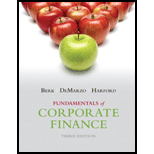
Fundamentals of Corporate Finance (3rd Edition) (Pearson Series in Finance)
3rd Edition
ISBN: 9780133507676
Author: Jonathan Berk, Peter DeMarzo, Jarrad Harford
Publisher: PEARSON
expand_more
expand_more
format_list_bulleted
Concept explainers
Question
Chapter 15, Problem 9CT
Summary Introduction
Callable bond:
The callable bond is that bond which has a special provision that allows that the issuer can repurchase the bonds at a price which is predetermined. This bond has a special call feature which allows that the bonds can be redeemed at a pre-decided specified date and price.
To explain: The situation when the yield to maturity is higher than the yield to call for a callable bond.
Expert Solution & Answer
Want to see the full answer?
Check out a sample textbook solution
Students have asked these similar questions
Finance question
7. A person buys a stock for $100 and sells it for $120. What is the gain?A) $10B) $20C) $25D) $15
A person buys a stock for $100 and sells it for $120. What is the gain?A) $10B) $20C) $25D) $15
i need help!!
If you invest $1,000 at 10% compound interest for 1 year, the amount is:A) $1,100B) $1,050C) $1,200D) $1,000
Chapter 15 Solutions
Fundamentals of Corporate Finance (3rd Edition) (Pearson Series in Finance)
Ch. 15 - Prob. 1CCCh. 15 - What are the four categories of international...Ch. 15 - Prob. 3CCCh. 15 - Prob. 4CCCh. 15 - Prob. 5CCCh. 15 - Prob. 6CCCh. 15 - Prob. 1CQCh. 15 - Prob. 2CQCh. 15 - Prob. 3CQCh. 15 - Prob. 4CQ
Ch. 15 - Prob. 5CQCh. 15 - Prob. 6CQCh. 15 - Prob. 7CQCh. 15 - Prob. 8CQCh. 15 - Prob. 9CQCh. 15 - What are the different types of corporate debt and...Ch. 15 - Prob. 2CTCh. 15 - Prob. 3CTCh. 15 - Prob. 4CTCh. 15 - What is the difference between a foreign bond and...Ch. 15 - 6. Why would companies voluntarily choose to put...Ch. 15 - Prob. 7CTCh. 15 - Prob. 8CTCh. 15 - Prob. 9CTCh. 15 - Prob. 10CTCh. 15 - Prob. 11CTCh. 15 - Prob. 1PCh. 15 - Prob. 2PCh. 15 - Prob. 3PCh. 15 - Prob. 4PCh. 15 - Prob. 5PCh. 15 - Prob. 6PCh. 15 - Prob. 7PCh. 15 - Prob. 8PCh. 15 - Prob. 9PCh. 15 - Prob. 10PCh. 15 - Prob. 11P
Knowledge Booster
Learn more about
Need a deep-dive on the concept behind this application? Look no further. Learn more about this topic, finance and related others by exploring similar questions and additional content below.Similar questions
- If you invest $1,000 at 10% compound interest for 1 year, the amount is:A) $1,100B) $1,050C) $1,200D) $1,000arrow_forwardI need help!! A loan of $5,000 at 6% interest for 2 years gives what simple interest?A) $600B) $500C) $300D) $200arrow_forwardA loan of $5,000 at 6% interest for 2 years gives what simple interest?A) $600B) $500C) $300D) $200arrow_forward
- Dear expert i need answer in this question!! What does ROI stand for in finance?A) Return on InvestmentB) Rate of InterestC) Revenue on IncomeD) Return on Insurancearrow_forwardI need help in this question!! What does ROI stand for in finance?A) Return on InvestmentB) Rate of InterestC) Revenue on IncomeD) Return on Insurancearrow_forwardI need help!! What is the full form of EMI?A) Equal Monthly IncomeB) Equated Monthly InstallmentC) Effective Money InvestmentD) Equal Money Interestarrow_forward
- No AI solution What is the full form of EMI?A) Equal Monthly IncomeB) Equated Monthly InstallmentC) Effective Money InvestmentD) Equal Money Interestarrow_forwardWhat is the full form of EMI?A) Equal Monthly IncomeB) Equated Monthly InstallmentC) Effective Money InvestmentD) Equal Money Interestarrow_forwardA higher credit score usually means:A) Lower loan approval chancesB) Better interest ratesC) No effect on creditD) More taxesarrow_forward
- 3. If $1000 is invested at 5% annual interest, how much will it be after 2 years (simple interest)?A) $100B) $1100C) $1050D) $110need help!!arrow_forwardNo AI What is meant by diversification in investment?A) Putting all money in one stockB) Avoiding investmentsC) Spreading investments to reduce riskD) Investing in real estate onlyarrow_forward3. If $1000 is invested at 5% annual interest, how much will it be after 2 years (simple interest)?A) $100B) $1100C) $1050D) $110arrow_forward
arrow_back_ios
SEE MORE QUESTIONS
arrow_forward_ios
Recommended textbooks for you
 Essentials Of InvestmentsFinanceISBN:9781260013924Author:Bodie, Zvi, Kane, Alex, MARCUS, Alan J.Publisher:Mcgraw-hill Education,
Essentials Of InvestmentsFinanceISBN:9781260013924Author:Bodie, Zvi, Kane, Alex, MARCUS, Alan J.Publisher:Mcgraw-hill Education,

 Foundations Of FinanceFinanceISBN:9780134897264Author:KEOWN, Arthur J., Martin, John D., PETTY, J. WilliamPublisher:Pearson,
Foundations Of FinanceFinanceISBN:9780134897264Author:KEOWN, Arthur J., Martin, John D., PETTY, J. WilliamPublisher:Pearson, Fundamentals of Financial Management (MindTap Cou...FinanceISBN:9781337395250Author:Eugene F. Brigham, Joel F. HoustonPublisher:Cengage Learning
Fundamentals of Financial Management (MindTap Cou...FinanceISBN:9781337395250Author:Eugene F. Brigham, Joel F. HoustonPublisher:Cengage Learning Corporate Finance (The Mcgraw-hill/Irwin Series i...FinanceISBN:9780077861759Author:Stephen A. Ross Franco Modigliani Professor of Financial Economics Professor, Randolph W Westerfield Robert R. Dockson Deans Chair in Bus. Admin., Jeffrey Jaffe, Bradford D Jordan ProfessorPublisher:McGraw-Hill Education
Corporate Finance (The Mcgraw-hill/Irwin Series i...FinanceISBN:9780077861759Author:Stephen A. Ross Franco Modigliani Professor of Financial Economics Professor, Randolph W Westerfield Robert R. Dockson Deans Chair in Bus. Admin., Jeffrey Jaffe, Bradford D Jordan ProfessorPublisher:McGraw-Hill Education

Essentials Of Investments
Finance
ISBN:9781260013924
Author:Bodie, Zvi, Kane, Alex, MARCUS, Alan J.
Publisher:Mcgraw-hill Education,



Foundations Of Finance
Finance
ISBN:9780134897264
Author:KEOWN, Arthur J., Martin, John D., PETTY, J. William
Publisher:Pearson,

Fundamentals of Financial Management (MindTap Cou...
Finance
ISBN:9781337395250
Author:Eugene F. Brigham, Joel F. Houston
Publisher:Cengage Learning

Corporate Finance (The Mcgraw-hill/Irwin Series i...
Finance
ISBN:9780077861759
Author:Stephen A. Ross Franco Modigliani Professor of Financial Economics Professor, Randolph W Westerfield Robert R. Dockson Deans Chair in Bus. Admin., Jeffrey Jaffe, Bradford D Jordan Professor
Publisher:McGraw-Hill Education
The U.S. Treasury Markets Explained | Office Hours with Gary Gensler; Author: U.S. Securities and Exchange Commission;https://www.youtube.com/watch?v=uKXZSzY2ZbA;License: Standard Youtube License